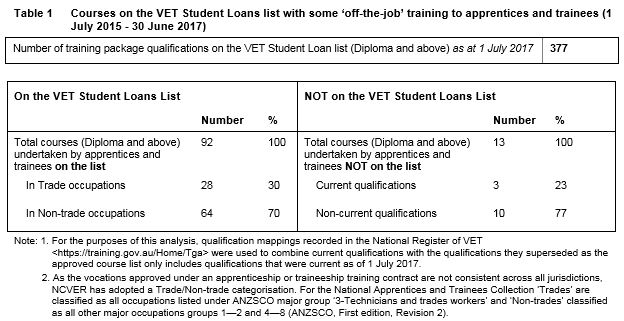This article examines apprenticeships and traineeships undertaken at a VET diploma level by cross reference to diplomas financed under the VET Student Loans (VSL) Approved Courses list.
The purpose is to examine which courses so listed have in the recent past been undertaken by an Australian apprentice or trainee at a ‘higher’ VET diploma level, and conversely what VET diploma-level courses were undertaken by an apprentice or trainee where their chosen course was not on this list.
The findings have public policy and funding implications. Data sources and methods are found in the annex below.
VSL list correlated with apprentices and trainees
There were 377 training package qualifications (not including other nationally accredited courses) on the VSL Approved Courses list (compiled 1 July 2017) at diploma and above (table 1).
Inspection shows that there were 92 (24 per cent) courses on this list with some evidence of enrolment in ‘off-the-job’ training by apprentices and trainees in the prior two-year period, 1 July 2015 to 30 June 2017. For the 92 courses on the VSL courses list, about one third were in trade occupations. The split between training in ‘trade’ and ‘non-trade’ occupations is shown in table 1.
There were only 13 courses found that involved some level of ‘off-the-job’ training by apprentices and trainees in the same period that were not on the VET Student Loans list. However, only three of these courses were still current as of 1 July 2017.
The top 10 courses on the VET Student Loans list with some ‘off-the-job’ training to apprentices and trainees between 1 July 2015 and 30 June 2017 were:
There were three courses with some ‘off-the-job’ training to apprentices and trainees between 1 July 2015 and 30 June 2017 that were are not (initially) on the VSL Courses list. Subsequently amendments to the list added the Diploma of Retail Leadership and the Diploma of Government Investigations. The Diploma of Property Services (Asset and Facility Management) is the only qualification found with apprentice and trainee activity during this period not included on the list.
Historic trends of apprenticeships and ‘higher’ VET qualifications
Most Australian apprentices and trainees study at certificate III level (some 86 per cent of those in training at 30 June 2018). The ‘in training’ numbers for apprentices and trainees at diploma and above levels was 8335 at the end of June 2018, a fall of 41 per cent from 14 160 at the end of June 2014. Over the 12 months ending June 2018, there were some 2915 completions at the diploma and above levels.
These are small numbers compared with the past, especially in the period 2009 to 2014, where ‘higher’ VET apprentices/trainees were in far greater numbers (figure 1).
Most diplomas undertaken by apprentices/trainees were in non-trade occupations, where over the period 2000–17 there were some 118,235 diploma commencements and 64,825 completions. Over the same period, there were fewer numbers in trade occupations with some 3545 diploma commencements and 2130 completions. Figure 1 shows (for non-trade and trade combined) the fast growth and sharp fall in VET ‘diploma’ level apprentices/trainees, the outcomes attributable to policy settings with impacts mainly on existing worker traineeships when incentives were truncated in ~2012. This illustrates the fluctuating pattern of recent ‘higher’ apprenticeships in Australia.
Implications and conclusions
Impact on Skilling Australians National Partnership (NP) Agreement
The NP set a target of up to 300 000 additional training contracts between June 2018 and June 2022, which includes up to 20 000 ‘higher’ apprenticeships. All states and territories are now signatories to the NP with the present exception of Victoria and Queensland (whose populations comprise about 45 per cent of all VET students).
Whilst the NP is designed to drive up numbers of ‘additional’ apprentices overall, the clear alignment between courses on the VSL list and those chosen by diploma-level apprentices and trainees indicates an alternate means of financing ‘higher’ VET apprentices outside the NP agreement.
The VSL listing criteria includes courses ‘which have a high national priority, meet industry needs, contribute to addressing skills shortages and align with strong employment outcomes’. Such intended benefits are the same to both apprenticeships and the VSL program, so their promoted integration is worthwhile. Such cross referencing also indicates a useful lens point for future inclusions on the list.
Industrial environment needs to be supportive
‘Higher’ level VET apprenticeships being financed under VSL will only work if this practically and financially suits the employer and apprentice, with minimum complexity or administrative burden. It requires ‘on-job’ work and ‘off-job’ training arrangements to be made in accord with approved industrial and wage arrangements. The evidence of past diploma-level apprentices shows this is practically possible. One complexity to be thought through perhaps is apprentices starting at the traditional certificate III level and then wanting to move up to diploma.
Any arrangements must clearly also meet VSL program rules, funding and limits. Notably the design and implementation of the VSL program has been positively affirmed by the Australian National Audit Office.
Possible market differentiation of VSL approved Registered Training Organisations (RTOs)
This approach has potential as positive market differentiation for approved VSL providers delivering such qualifications. The VSL statistical report (first 6 months 2018) indicates a total of 180 RTOs operated as approved VSL course providers including 23 TAFEs, 13 other public organisations (including University Table A providers) and 144 private providers. Promotion might best suit dual-sector institutions.
Higher Apprentices – both VET and Higher Education (HE)
One view is that apprenticeships are fundamentally an employment arrangement and seen on that axis alone the descriptor ‘higher’ is meaningless. ‘Higher’ indicates the AQF level of study. By dint of ‘custom and practice’ set in industrial arrangements and training traditions, employers and apprentices have long been anchored (but not bound) on contracts of training with certificate III qualifications.
Other nations and economies have debated and consciously ‘stepped over such old shadows’. Evidenced on the future skills needs of their workforces, especially in manufacturing in response to Industry 4.0, they now actively promote higher vocational/degree level apprentices in their policies and practices.
It has been mooted that revised policy could require some Sub-bachelor courses at Australian universities to be undertaken as apprenticeships. If a VET ‘higher’ apprenticeship can have its ‘off-job’ training financed by a VSL at AQF 5-6 levels, it becomes increasingly irrational not to facilitate the same with public funded or financed HE courses at the same AQF levels. There are ongoing limited pilot examples.
Whilst the future outcomes and performance of the Skilling Australians NP is way off and uncertain, at least for VET ‘higher’ apprentices, there is an alternate VSL financed route to help lift numbers, if employers in leading industry sectors are willing and able to step up to this opportunity.
The recently proposed VET sector review by the current national government and earlier proposed post-secondary review by the alternate national government, together with outcomes from the ongoing AQF review, provides opportunity and content for imaginative policy reform.
Annex: definitions, data and method
Consistent with the Skilling Australians Fund National Partnership Agreement, a ‘higher apprenticeship’ at a VET diploma or higher diploma levels ‘combines a program of structured on-the-job training with formal study with the study component leading to the award of a VET qualification at the Australian Qualification Framework level 5 (diploma) or level 6 (advanced diploma)’. ‘Higher’ does not include HE AQF levels 5 and 6 (diploma, advanced diploma and associate degree), or AQF level 7 (Bachelor degree).
Per table 2, the published list of VET Student Loan courses, compiled 1 July 2017, was used to enumerate corresponding activity of apprentices and trainees at diploma and above in the National Apprentice and Trainee Collection in a recent two-year period. The time span for extraction of data was arbitrarily chosen as being within the two-year span 1 July 2015 to 30 June 2017.
This makes the analysis relating a point in time (publication of a course list) with an earlier span of time (evidence of activity). This activity is presented as either ‘Trade’ or ‘Non-trade’ rather than ‘apprentices’ and ‘trainees’. ‘Trades’ are classified as all occupations listed under ANZSCO[1] major group ‘3-Technicians and trades workers’ and ‘Non-trades’ classified as all other major occupations groups.
 Dr Craig Fowler is an analyst and observer of national policies impacting tertiary education, science and innovation after decades of experience in private, public and university sectors.
Dr Craig Fowler is an analyst and observer of national policies impacting tertiary education, science and innovation after decades of experience in private, public and university sectors.
Acknowledgment: NCVER staff and expertise. Contact: [email protected]
Reference:
[1] The Australian and New Zealand Standard Classification of Occupations (ANZSCO) ABS 1220.0 http://www.abs.gov.au/ANZSCO
Do you have an idea for a story?Email [email protected]
 Campus Review The latest in higher education news
Campus Review The latest in higher education news





